
Written by Sebastian R. Prange
Before Europeans found their way to the Indian Ocean, Arab mariners and merchants dominated the all-important pepper trade on India’s spice coast. There they established communities characterized by a unique blend of Islamic traditions and South Indian customs.
 |
HERMAN MOLL (1736) Alexander the Great is believed to have brought dried black peppercorns back from India. His travels brought back also its Sanskrit name, pippali, from which, via Greek and Latin, we derive both our word for the spice and the plant’s scientific name, Piper nigrum. |
Today pepper is our single most commonly used spice, routinely offered in fine restaurants and fast food joints alike and universally available in stores and supermarkets. It is therefore hard to imagine just how highly prized pepper was in ancient and medieval times and how it spurred a complex trade that saw peppercorns travel distances so enormous that their origins remained obscure even to their purveyors. Along the way, fortunes were made, lives were lost, and the spice became enriched with its connotations of mystery and exoticism.
Since at least the first millennium BC, pepper was regarded as an ultimate luxury, inessential to survival yet highly desired for ritual, medicinal and culinary purposes. The origins of this desire stretch back to ancient Egypt, with the great pharaoh Ramses II being the first known consumer, albeit posthumously: peppercorns were found in the nostrils of his mummified corpse. In ancient Greece, pepper was used medicinally and the Chinese have used it in their cooking since at least the fourth century. The Romans’ conquest of Egypt gave them regular access to pepper, and it became a symbol of luxurious cookery. It was traded ounce for ounce with precious metals: When Rome was besieged in the fifth century, the city allegedly paid its ransom in peppercorns, and the spice remained an accepted form of “currency” throughout the Middle Ages.
The period from roughly the first century BC to the first century of our era witnessed a surge in the pepper trade as navigators began to understand the pattern of the Indian Ocean monsoon, and the surge resulted in more detailed knowledge about the lands where the pepper grows.
In 70 AD, the Periplus Maris Erythraei, an anonymous merchant’s guide to the Red Sea, recorded information on the spice trade and the now lost Indian port of Muziris. Large ships are sent there, the author reports, “on account of the great quantity and bulk of pepper” that is only grown in that region. Even though archeologists still debate its exact location, it is clear from the Periplus and other references that Muziris was located near the modern city of Kodungallor (formerly known as Cranganore, its colonial name) on India’s Malabar Coast, where black pepper is native.
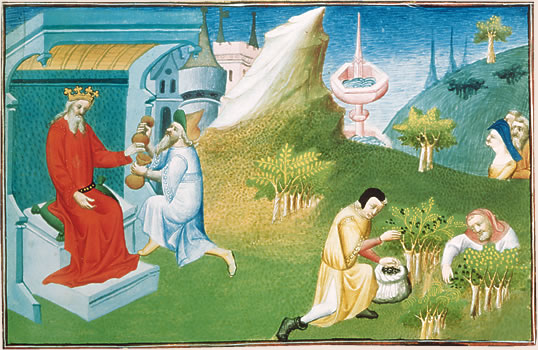 |
BIBLIOTHEQUE NATIONALE / BRIDGEMAN ART LIBRARY Pepper was once a gift fit for kings; above, a French manuscript illustration from the early 15th century shows both harvesting and royal presentation. |
The Malabar Coast comprises a narrow sliver of land on the southwestern tip of peninsular India, hemmed in by the Arabian Sea to the west and the mountain range of the Western Ghats in the east. This region, now largely contained in the northern part of the Indian state of Kerala, is located in the humid equatorial tropics: the annual monsoon rains nourish the fertile soil, feed the extensive network of backwater canals, and support the region’s rich biodiversity. In addition to being the source of pepper, Malabar’s position at the center of the Indian Ocean made it a natural location for commerce and transshipping. For these reasons, foreign merchants hailing from the different corners of the Indian Ocean trading world established settlements in Malabar’s ports and brought with them not only their commercial expertise but also their cultures and creeds.
As the original suppliers of pepper to the Mediterranean world, the Persians had sailed along the coast to Malabar since the earliest days of maritime navigation. Jews are believed to have arrived and established synagogues as early as the sixth century BC. The Christians of modern Kerala trace their ancestry to Thomas the Apostle, who they believe came to Muziris in the year 52; they are known to this day as St. Thomas Christians.
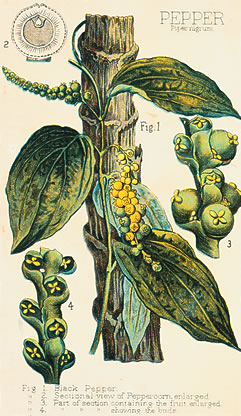 |
CYNTHIA HART DESIGNER / CORBIS Peppercorns are the dried fruit of the wild climbing vine Piper nigrum, which is native to the rich soil and humid climate of the Malabar Coast. It is unrelated to the American chili fruit, often called “chili pepper.” |
In the same century, ships from China reached South India and created the long-lasting connection between the Chinese empire and Malabar: This was as evident to medieval visitors, who spoke of Malabari communities known as “sons of the Chinese,” as it is to modern tourists who marvel at the peculiar shore-based fishing contraptions known as “Chinese nets.”
Traders from other parts of India, especially Gujarat to the north and Coromandel on the east coast, also established permanent trading communities on the Malabar Coast, often specializing in particular goods. But what would prove to be the most profound foreign influence on Malabar did not arrive for another five centuries, when a new religion spread across the lands around the Indian Ocean, galvanized their commerce and created immense wealth through the trade in pepper.
Despite their reputation as a desert people, Arabs had long been involved in maritime trade. Yet it was only with the unifying, expansionist and proselytizing energy of early Islam that Arabs were able to develop their traditional dominance over the caravan and Red Sea trade into a network of Muslim settlements that rapidly spread along the Indian Ocean littoral. Under the early caliphates, this Islamic network matured to encompass most of the Indian Ocean world from East Africa to the southern coast of China. It carried with it not only the beliefs of Islam but also the Arabic language, shari’a courts able to enforce common legal standards and shared commercial practices that favored the interaction of these settlements. Merchants residing in foreign ports were able to learn the local language, establish and maintain business contacts, and act as cross-cultural brokers. Muslim trade settlements developed into particularly effective organizations because of the political unity initially created by a burgeoning Islam, the great emphasis on literacy within its culture and the practice of pilgrimage, which kept its heartlands in communication with even the most far-flung settlements. Even though the bulk of Indian Ocean commerce was carried on Indian and Chinese ships, and despite the continued significance of Jewish merchants, Arab Muslims increasingly dominated trade in its most profitable commodity: pepper.
The momentous commercial expansion during the early centuries of Islam was driven by the demand for spices in Europe and in the grand capitals of the new Islamic states. Within the lucrative spice trade, pepper was the most important commodity in bulk and value, and so the Malabar Coast remained of central importance to the Indian Ocean trading world. In his description of Malabar, the 14-century Moroccan traveler Ibn Battuta recorded his astonishment at seeing pepper, elsewhere valued by the grain, “being poured out for measuring by the bushel, like millet in our country.” It is therefore not surprising that Malabar was the first region of India to attract Muslim traders in significant numbers. The Malabar Coast was originally inhabited by the Dravidian people, who were distinct in their languages and culture from the Indo-Aryans of northern India. Organized religions came to Kerala in the form of Jainism, Buddhism and later Hinduism, and expressed themselves in the construction of temples—their profusion in the region has led Kerala to be called “the land of temples.” A revived Hinduism developed into the region’s predominant religion from about the ninth century onward, when Kerala’s royal houses patronized Brahmins from North India.
Pepper
Pliny, writing his Natural History in the first century, was puzzled by the demand for pepper that dictated its high price: “Its fruit or berry are neither acceptable to the tongue nor delectable to the eye: and yet for the biting pungency it has, we are pleased with it and must have it set forth from as far as India.” By Pliny’s time, pepper had long been part of European commerce and imagination about the East. Alexander the Great is believed to have brought pepper back from his expeditions. He introduced its Sanskrit name, pippali, from which the Greek piperi was derived and passed on to the Semitic languages (Hebrew pilpel and Arabic filfil) as well as to the European languages through the Latin piper.
Today pepper is still considered the “king of spices” and added to almost any kind of recipe. Pepper was already the most frequently used oriental spice in medieval Europe, and descriptions of lavish banquets often refer to the luxuriously large quantities of pepper used in their preparation. Aside from its culinary function of spicing up foods, pepper was also valued for its supposed medicinal properties, in particular as an antidote to poisoning and as a cure for impotency. Its high price relative to volume also made it a useful currency: The Roman emperors stored great amounts of it in their treasury. As information about the East increased in late antiquity, so did the knowledge about the plants and regions that produced this most sought-after commodity.
Peppercorns are the dried fruit of the wild climbing vine Piper nigrum, which is native to Kerala. The vine grows readily and widely in the rich soil and humid climate of southern India and reaches several meters in height by climbing trees or trellises. Medieval travellers to Malabar were amazed at how widely the pepper vine was cultivated, with even the smallest gardens including at least a few plants. Black, white and green pepper are all fruits of Piper nigrum. The peppercorns are usually picked unripe. If they are then brined or freeze-dried, they remain green and keep a fresh, vegetal flavor and a mild tang. If they are sun-dried, the flesh of the fruit blackens and shrivels to a thin coating and the spice develops a richer flavor as well as more heat. To produce white pepper, with heat but little flavor, the peppercorns are soaked in water and the flesh is then rubbed off the seeds. Rarely, peppercorns may be allowed to ripen to red before being picked. The name “pepper” has been profitably applied to many other plants—Malaguetta pepper, long pepper and all the New World capsicums (chili peppers)—but true pepper is only Piper nigrum, and the connoisseur’s choice is Malabar pepper, preferably the deep-flavored grade the trade calls Tellicherry Extra Bold. |
The origins of Islam on the Malabar Coast began, according to legend, with the last king of the South Indian Chera dynasty, which had ruled Malabar since the beginning of its recorded history. Cheraman Perumal, the tale goes, converted to Islam after having dreamt of a splitting moon and then meeting Arab pilgrims who reported that the Qur’an mentions just such a miracle (54:1–2). The king resolved to join the pilgrims in their journey to Makkah, but not before dividing his kingdom among his princes, a fragmentation that would characterize the region for many centuries.
Having fallen ill on the return journey and unable to make it to his homeland, the king entrusted the same pilgrims with the mission of founding mosques and propagating his new faith in Kerala. Many of the oldest mosques in the region are said to have been founded by these pilgrims, who were dispatched all along the coast to serve as qadis to its fledgling Muslim communities.
The legend of Cheraman Perumal is similar to conversion myths in other parts of Asia and appears to be a confusion of two distinct traditions, one relating the end of unified Chera rule over Kerala and the other the conversion of a king. Its appeal and longevity, however, are testament to the exceptional circumstances that surrounded the introduction of Islam to Kerala and to the unique history of the communities it created. Furthermore, many aspects of this tale can be linked to historical truths. To begin to understand this blend of fact and fiction, therefore, we must look at the intriguing history of the Muslims of Malabar and their unique blend of Islamic traditions and South Indian customs.
Islam was introduced to the Malabar Coast peacefully by Arab traders in search of pepper and by Sufis who traveled within the commercial networks. To this day, most Muslims of Malabar adhere to the Shafi’i school of Islamic law, which was dominant among Muslim merchants across the Indian Ocean world. They are also more closely linked to Arab culture than to the Persian influence that was brought to the rest of India by invaders from the north. Muslim merchants settling in Malabar ports married (often multiple) local women. Their offspring were the first generation of Indian-born Muslims, and their upbringing in both Arabic and the local language, Malayalam (not related to the Malay language of Southeast Asia), was an excellent preparation for future work as brokers. In this manner, the ports of the Malabar Coast became ever more closely woven into the network of Islamic trade spanning the Indian Ocean, and the wealth of the expatriate merchants and their associates increased.
As the legend of Cheraman Perumal already suggests, another significant factor in the introduction of Islam to Malabar was conversion. Aside from rare exceptions, these did not, however, occur in the ruling class but in the lower strata of society. Hinduism in this part of South India had developed a particularly rigid system of caste division, with social intercourse between castes severely restricted to avoid ritual pollution. Conversion to Islam was therefore a chance for low-caste Hindus to break free of such limitations, and also opened new opportunities for economic interaction with the prosperous Arab merchants. This group of new Muslims native to Malabar developed into a distinct community known as Mappilas (or Moplahs). These new converts preserved many of their traditional practices and integrated them into their new Islamic identity. Some Mappilas, for instance, continued the practice of matrilineality in which descent is understood to be of the mother’s bloodline. The particular cultural heritage of this community is preserved in the Mappila songs, an indigenous form of devotional folklore in the Malayalam language.
From about the thirteenth century onwards, Kozhikode (anglicized “Calicut”) emerged as the coast’s dominant port. It was the center of a princely state ruled by hereditary sovereigns known as Zamorins. These were particularly renowned for their tolerance on the one hand—they for instance granted merchant communities independent jurisdiction over their members—and their scrupulousness in upholding property rights on the other, and they built a reputation for honesty that helped to turn Kozhikode into the region’s principal port. Ibn Battuta explicitly states that, because of this reputation, Kozhikode had become “a flourishing and much frequented city” and one of the most important ports in the world. Foremost among its cosmopolitan assemblage of foreign merchants were the Muslim traders. These became over time not only the Zamorins’ main source of tax revenue but also allies in their ambitions to subjugate other princely states, often through the provision of ships and sailors for naval warfare. Historians such as K. M. Panikkar are of the opinion that the Zamorins were on course towards subjecting and unifying Malabar under their rule, but that “this very process gave rise to jealousies and feuds” that were easily exploited by the Portuguese after their arrival on the coast.
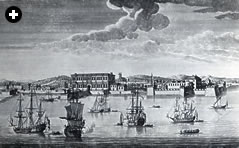 |
JAN VAN RYNE / PRIVATE COLLECTION / BRIDGEMAN ART LIBRARY
Pepper’s high profits helped propel European colonialism, and this engraving depicts the port of Bombay (now Mumbai) in the mid-18th century, when much of Malabar’s pepper exports passed through that entrepôt into the holds of ships of the British East India Company. |
When Vasco da Gama’s fleet reached Kozhikode in May 1498, he came “in search of Christians and spices.” He was initially content to imagine having found the former: He believed the Hindus to be an aberrant Christian sect and even offered prayers at a Hindu temple, albeit somewhat puzzled by the depiction of “Our Lady” with multiple arms. The desire for a monopoly of the pepper trade, however, was more difficult to quench: The Portuguese soon realized the prominence of Arab traders in the town and their control over the pepper trade. Laden with a profound antagonism toward Muslims born of the Reconquista, the Portuguese were not content to trade alongside other merchant communities. When the second fleet reached Malabar in 1500, its commander, Cabral, demanded that the Zamorin expel all Muslim merchants from the port. This stood in marked contrast to the long tradition of free trade that had been the source of Kozhikode’s prosperity, and the ruler responded (in the words of the Portuguese chronicler) that he could not comply “for it was unthinkable that he expel 4000 households of them, who lived in Calicut as natives, not foreigners, and who had contributed great profits to his Kingdom.”
Already during the second European expedition to India, confrontation became inevitable: While the Europeans were no match for the economic strength of Muslim merchants, their ship-mounted artillery and military expertise proved to be the force majeure. The Portuguese seized and destroyed Muslim merchant vessels, regularly bombarded Kozhikode and other ports, and exploited rivalries among the coast’s princely states to establish fortified factories.
They used their advantage in maritime violence to enforce a royal monopoly on the spice trade and to sell permits to other ships that wished to trade on the coast, and the Portuguese “pepper empire” was born.
The initial returns on the expeditions were staggering, and Lisbon soon replaced Venice as the main importer of pepper to Europe. But the Portuguese violence in India also galvanized resistance. The Zamorins together with the Muslim merchants repeatedly assembled fleets, but despite some small victories they could not break the Portuguese domination of the sea. The ruler of Kochi (formerly Cochin) to the south of Kozhikode, who had long been a resentful subject of the Zamorins, allowed the Portuguese to build a factory as their base on the Malabar Coast. A long period of warfare at sea and on land ensued, and repeated attempts were made to incite other Islamic states to assist the Mappilas’ struggle. Egyptian merchants were able to rouse the Mamluk sultan to send a fleet, but after inconclusive engagements his ships retreated. As Portugal’s power in the Indian Ocean expanded over the following decades, Malabar developed into a major test case of their imperial ambitions. Foreign Muslims were able to move to safer ports and conduct their business from there. That they did so successfully is evident by the great quantities of pepper that again became available in the markets of Alexandria and Venice by the mid-16th century, often undercutting the prices at which the Portuguese could sell it at Lisbon. The local Mappila Muslims, on the other hand, had no choice but to stay and to resist or evade the Portuguese monopoly system.
Excluded from the opportunities of regular commerce, the Mappila communities became increasingly militarized. While some resorted to smuggling and indiscriminate piracy, others turned to forms of guerrilla warfare to harass Portuguese shipping. The Portuguese, claiming ownership of all of the sea, soon described all Mappilas as pirates and treated them as such. The Mappilas used small ports in northern Malabar as bases, and by the mid-16th century a Muslim called Kunjali Marakkar was granted the hereditary admiralty of the Zamorin’s fleet. He and his successors inflicted several defeats on Portuguese armadas, but when, toward the end of the century, Kunjali iv asserted his independence of the Zamorin, the ruler allied with the Portuguese and together they eventually defeated the Mappila strongholds.
Around the same time, the Muslim historian Zain al-Din, whose family had come to Malabar from Yemen in the 15th century, wrote his famous Tuhfat al-Mujahidin (Gift to the Holy Warriors) describing the cruelty of the “Franks” in an attempt to persuade the Muslim states of northern India to assist the Mappilas in their struggle. The historian Stephen Dale argues that the Mappila Muslims developed a particular idiom of holy warfare that, instead of reflecting the conquest of new territories by Muslim powers, expressed a religious struggle born of individual desperation. This found expression in popular festivals (the nerccas), at which folk ballads celebrating the Mappila victims of the anti-colonial struggle are recited.
The profits of the pepper trade eventually motivated other European powers to join the fray, and in time the Portuguese were eclipsed first by the Dutch and later by the British. Throughout the centuries, economic and political circumstances continued to conspire against the Mappilas and led to recurrent riots and attacks. However, the Mappilas also preserved their link to the sea, mostly as fishermen in Kerala’s rich waters, and strengthened their involvement in riverine trade and agriculture. Today, Muslims constitute about a quarter of Kerala’s population and remain concentrated in the north of the state on the historic Malabar Coast; in contrast to other regions of India, Kerala experiences very little of the problems of sectarianism. In recent years, many Mappilas have found work in the Middle East, particularly in Saudi Arabia and the United Arab Emirates, and so continue the long-standing ties that bind the regions and societies. While historically pepper may have been as much of a blight as a blessing for the Malabar Coast, there can be no doubt that, because of it, the region served as a nexus where the dynamics of world history were played out —a point for reflection on the next turn of the pepper mill.
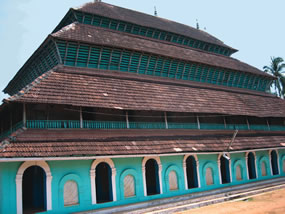 |
SEBASTIAN PRANGE
The Nakhuda Mithqal Mosque (or Mithqalpalli) in Kozhikode is named for a 14th-century Arab merchant and dates to 1578, when it was rebuilt following destruction of the original by the Portuguese. |
 |
BASEL MISSION PICTURE ARCHIVE
High roofs and slatted clerestories helped traditional Mappila mosques, such as this one photographed in 1936 in Ponnani, maintain comfort for worshipers in the hot coastal climate. |
Malabar Mosques
Kerala is known as “the land of temples” for its multitude of Hindu places of worship, but its little-known mosques are no less fascinating in their style and history. The Malabar Coast is believed to have been the site of the first mosques on the Indian subcontinent, but because of the destruction brought by Portuguese bombardments and subsequent invasions, there are no mosques that date before the 12th century. The earliest extant mosques are located in the old Muslim quarters of Kozhikode and Kochi and bear inscriptions noting donations from Arab merchants and shipmasters. These traditional mosques (palli in the local language, Malayalam) are remarkably different from the styles of Islamic architecture found in Arabia or elsewhere in India: For example, they do not feature domes or minarets. Rather, they show clear similarities to the design of vernacular houses and local Hindu temples. This is partly a result of the region’s particular conditions (for instance, the steeply sloped roofs to cope with the large amounts of rainfall) and the available materials and skills. Yet the similarities were not only dictated by necessity but may also reflect the desire to find a place in the prevailing ritual landscape: New converts to Islam would have already had clear ideas about what constitutes a sacred space from the region’s existing temples.
The archetypal Malabar mosque is a covered structure on a rectangular ground plan, often with verandas running around the prayer hall. Especially characteristic is the intriguing tiered roof structure, sometimes covered with copper sheets, with the upper stories often used as a madrasa and as offices for the imam. Mehrdad Shokoohy, a historian and architect, has recently studied the mosques of Malabar and describes in detail the amalgamation of local designs with specific features from the Arabian lands and Southeast Asia. In this view, Malabar’s mosques are a fitting manifestation of the remarkable extent of the medieval Muslim trading world and its spirit of cross-cultural stimulation and exchange.
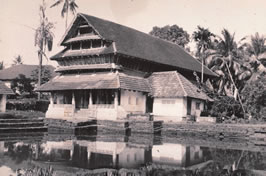 |
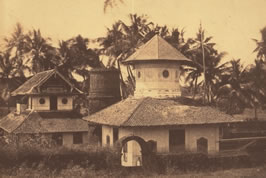 |
BASEL MISSION PICTURE ARCHIVE (2)
Left: A mosque in an unrecorded location, circa 1939. Right: A mosque near Chirakkal, circa 1855. |
|
 |
Sebastian R. Prange (prange@soas.ac.uk) is a doctoral student in history at the University of London’s School of Oriental and African Studies, where he is researching the history of Muslim trading communities on the medieval Malabar Coast. |





